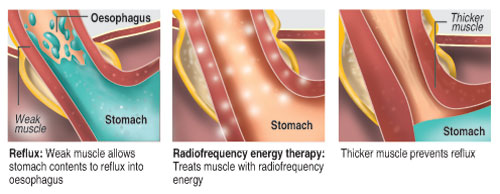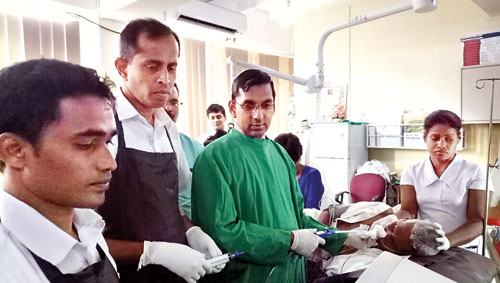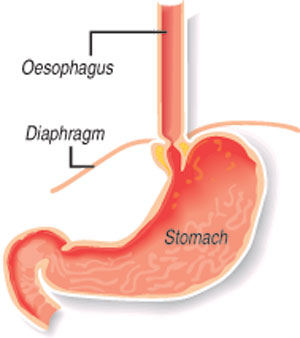Good riddance to GERD
Heartburn, belching and vomiting, it’s all part of the condition which makes many men and women miserable and if neglected may lead to serious consequences. Caused when the acid in the stomach, without going into the intestines, comes up to the oesophagus (the long, muscular tube which links the mouth to the stomach), numerous are the sufferers of Gastro-oesophageal Reflux Disease (GERD).
 Now, Sri Lankans are being offered a cure for GERD, without medications or cuts, but through a minimally-invasive procedure. The first such endoscopic procedure — radiofrequency energy therapy — in the country was performed by Consultant Gastroenterologist and Hepatologist, Dr. Sanjeewa Aryasingha attached to the Colombo South (Kalubowila) Teaching Hospital in May.
Now, Sri Lankans are being offered a cure for GERD, without medications or cuts, but through a minimally-invasive procedure. The first such endoscopic procedure — radiofrequency energy therapy — in the country was performed by Consultant Gastroenterologist and Hepatologist, Dr. Sanjeewa Aryasingha attached to the Colombo South (Kalubowila) Teaching Hospital in May.
Appreciating the unstinting support extended by the hospital’s Director Dr. Asela Gunawardena who always facilitates the introduction of new technology, Dr. Aryasingha also commended his team for their commitment.
Before looking at the procedure which provides relief to GERD sufferers, Dr. Aryasingha explains the difference between gastritis and GERD.
While the inflammation (becoming swollen and puffed up) of the stomach lining is gastritis, GERD is when the inside of the oesophagus gets inflamed leading to oesophagitis, he says. “This happens when the acid in the stomach needed for the digestion of food, harms the lining of the oesophagus.”
It is dangerous because prolonged oesophagitis could lead to Barrett’s oesophagus which is a serious complication of GERD, stresses Dr. Aryasingha pointing out that the normal tissue lining of the oesophagus changes to tissue that resembles the lining of the intestine. This is due to constant exposure of the cells in the lower oesophagus to acid.
Another serious consequence of such prolonged and persistent exposure to acid could be cancer. This is why there is much concern over GERD, he says.
The causes of GERD are:
Smoking
Chocolate
Caffeine
Foods – which delay the emptying of the stomach
Hiatus hernia – usually, the oesophagus passes through the hiatus (an opening in the diaphragm — the muscular wall separating the chest cavity from the abdomen) and attaches to the stomach. In this condition, the stomach bulges up into the chest through that opening

Dr.Sanjeewa Aryasingha (in green) performing the first-ever procedure for GERD with no cuts or stitches, only radiofrequency energy
Long-standing diabetes (a chronic condition associated with abnormally high levels of sugar or glucose in the blood), which delays the emptying of the stomach.
Looking into the digestive system, Dr. Aryasingha says that usually the stomach should empty in six hours, starting a ½-hour after the entry of food into it, and clearing all food in six hours. If this process does not take place on schedule, there is bloating of the stomach, along with acid reflux.
Earlier, the answers to GERD in Sri Lanka were lifestyle modifications along with medications and fundoplication surgery, MediScene learns.
The lifestyle modifications recommended for GERD, according to Dr. Aryasingha are:
The stoppage of smoking
Obesity reduction through a strict diet and exercise plan
Halting the intake of wheat flour, excessive oil, alcohol and coffee
This Consultant Gastroen-terologist explains that the person is also prescribed medications in the form of various syrups and tablets to promote a reduction in the formation of acid and to empty the stomach quickly.
If all these measures fail, an oesophageal manometry test is performed to measure how the oesophagus is working, by passing a thin, pressure-sensitive tube through the nose, down the oesophagus to the stomach.When the tube is in the stomach, it is pulled slowly back into the oesophagus, with the patient being asked to swallow. This allows the pressure of the muscle contractions to be measured along several sections of the tube.
 “This test measures the pressure in the oesophagus and helps assess the patient’s suitability for surgery,” says Dr. Aryasingha.
“This test measures the pressure in the oesophagus and helps assess the patient’s suitability for surgery,” says Dr. Aryasingha.
Before Sri Lanka initiated radiofrequency energy therapy, what doctors did as a last resort was fundoplication surgery, either through a keyhole (laparoscopic) procedure or open surgery.
In fundoplication surgery, the upper curve of the stomach (the fundus) is wrapped around the oesophagus and sewn into place so that the lower portion of the oesophagus passes through a small tunnel of stomach muscle. This is to strengthen the valve (lower oesophageal sphincter) between the oesophagus and the stomach, to stop acid from going back into the oesophagus.
Fundoplication surgery is usually performed when the cause of GERD is a hiatus hernia, which is also repaired during the procedure.
| The procedure Explaining the newly-introduced minimally-invasive procedure using a special device to give radiofrequency energy to the affected area, Dr. Sanjeewa Aryasingha says that it takes only about one hour. There are no cuts (incisions), stitches or implants and it is performed as an outpatient procedure. The patient can resume his/her normal activity the very next day.In this procedure, the device is sent down the oesophagus through the mouth and delivers radiofrequency energy to the muscle in the lower oesophagus. This energy stimulates the muscle to enlarge, thereby strengthening the lower oesophagus sphincter, thus preventing the acid coming back up again. | |


